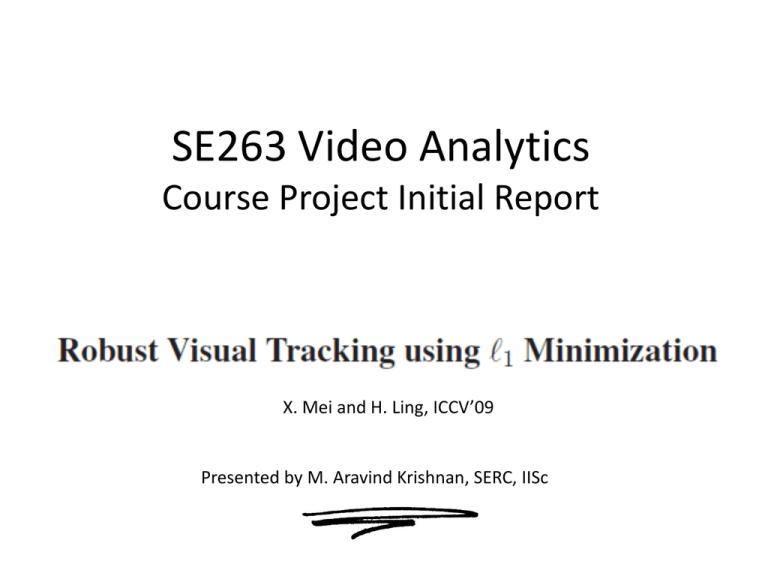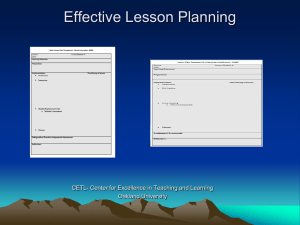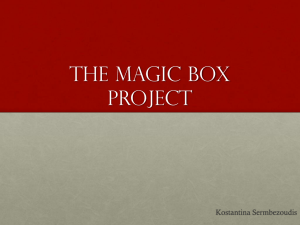SE263 Video Analytics Course Project Initial Report
advertisement

SE263 Video Analytics Course Project Initial Report X. Mei and H. Ling, ICCV’09 Presented by M. Aravind Krishnan, SERC, IISc AIM of the course project is to implement and if possible, improve the work done by Xue Mei and Haibin Ling in visual tracking, as explained in their paper Robust Visual Tracking using l1 minimization. By ‘improve’ it is meant to ‘accelerate’ the speed of execution using special processing hardware called Graphics Processing Units. OVERVIEW 1. I will begin by explaining the work done in the paper, and the various mathematical tools used in achieving the desired results. 1. Bayesian state inference framework, used to predict the affine state of the object. (Called the particle filter) 2. Sparse representation of the Tracking target. 3. Non-negativity constraints 4. l1 minimization 5. Template update 2. This will be followed by a brief overview of Graphics processing Units, and how they can be used for general purpose computation. 3. Finally the parts of the algorithm most suited for being executed in a GPU is proposed. Templates • Sample/collection of possible views of the object, whose linear combination can be used to represent the tracked object in the frame. • Two types of templates are considered in this paper, Target templates and Trivial templates. • Target templates to deal with various lighting conditions, poses, etc. • Trivial templates to deal with occlusions, noise, bacckground clutter, etc. Templates continued • Target templates are densely used to represent, and hence are less in number. • Trivial templates are sparsely used to represent, and hence can be large in number. State of object being tracked Xt = 2D deformation parameters 2D translation parameters If zt is the observed distribution of the state of the object at time t, then the predicted distribution of the object xt is given by the recursive computation "filtering" refers to determining the distribution of a latent variable at a specific time, given all observations up to that time; particle filters are so named because they allow for approximate "filtering" using a set of "particles" (differently-weighted samples of the distribution). -Wikipedia l1 minimization Non negativity Optimization Convex Optimization – Interior point method The method uses the preconditioned conjugate gradients (PCG) algorithm to compute the search direction and the run time is determined by the product of the total number of PCG steps required over all iterations and the cost of a PCG step. This process can be accelerated by GPUs. Algorithm for template update Review of Algorithm 1 2 3 4 5 Frame 1 1. Manually detect object to be tracked 2. Initialize Target Templates with random variations of object Generate a set of N states around current state Xt, with each of the 6 affine parameters being modeled as an independent gaussian variable. Represent each of the N generated states as a sparse linear combination of target and trivial templates by solving the l1 minimization problem min||Bc-y||22+λ||c||1 Calculate p(Xt|Z1:t ) by determining the Bayesian weights of the importance wi = p(zt|xt), in turn determined from the errors/residuals in projecting the tracked object onto each of the solutions of 3. Update templates if the highest similarity of the templates with newly tracked object is less than a threshold. Do by replacing lowest similarity template with the newly tracked object. Working of a GPU • Consists of a lot ALUs. Banks of ALUs with shared memory are called cores. • An average CPU consists of upto 4 SIMD units. • A GPU consists of 32-128 SIMD units • A tesla C1060 unit available in SERC will be used to try and speed up the optimization process, and hence the whole algorithm. The functionality of GPUs – Data Parallelism • GPUs are extremely good at executing the same instruction across bulky data. Eg. Vector addition, Matrix Vector Multiplication, BLAS routines, etc. • The major bottle-neck of this algorithm is the convex optimization performed using Interior point method. It involves some matrix vector operations over the same matrix and around N different vectors. This can be readily and trivially parallelized, and great speedup can be achieved if done carefully. Architecture of GPU Goals and tasks of project • Dividing the minimization algorithm amongst the cores of the GPU, and figuring out optimal grid configuration. • Optimizing to perform the whole task with minimal data transfer from CPU to GPU and performing the algorithm in real time using just one kernel invocation, for a long video. • Achieve a frame rate > 30 fps on Tesla C1060. • Achieve frame rate of 18 fps or more using ATI mobility Radeon HD 5650 graphics processor with 1Gb internal memory available in my laptop. (requires transcription to OpenCL. Under constraints of time) Thank you




